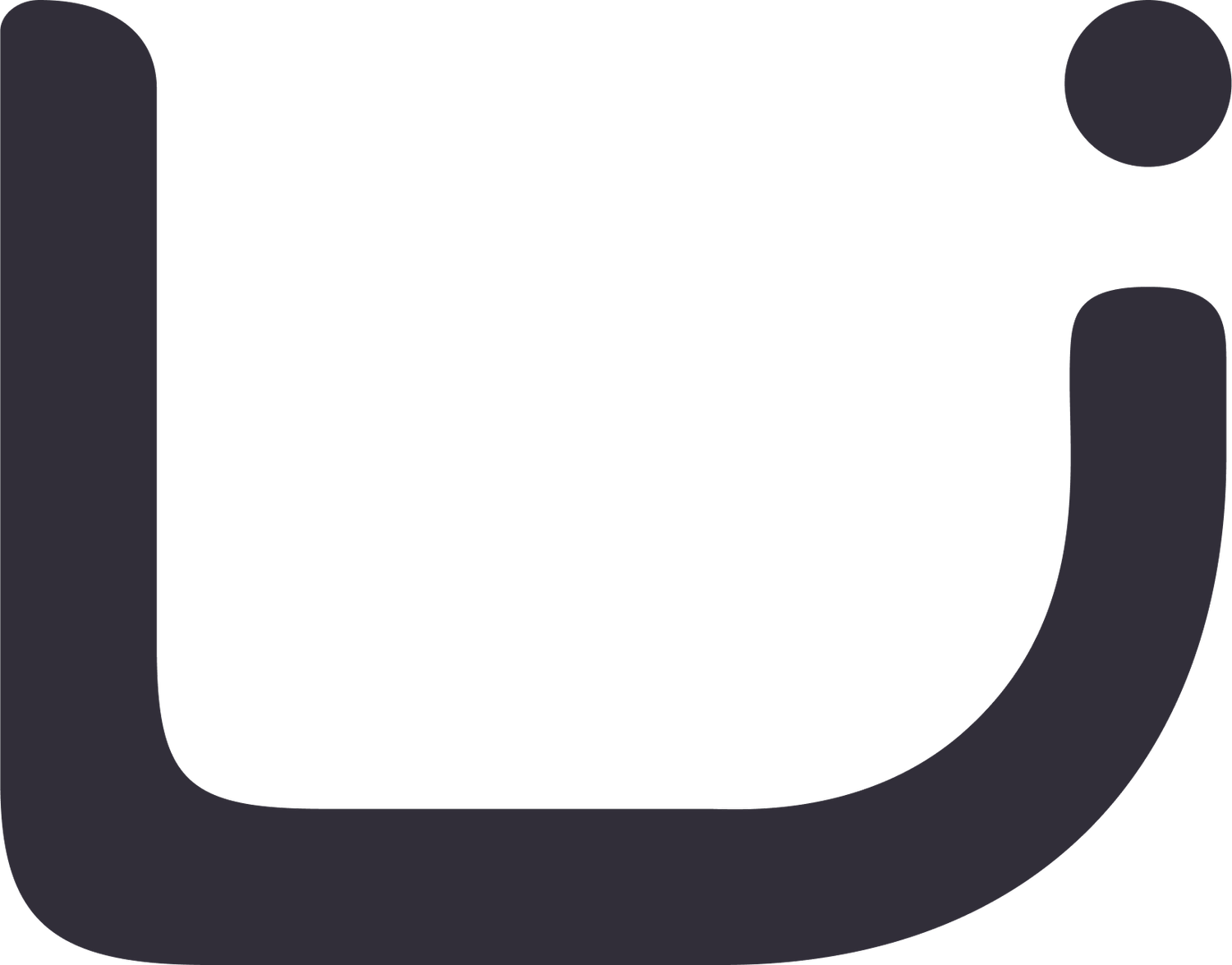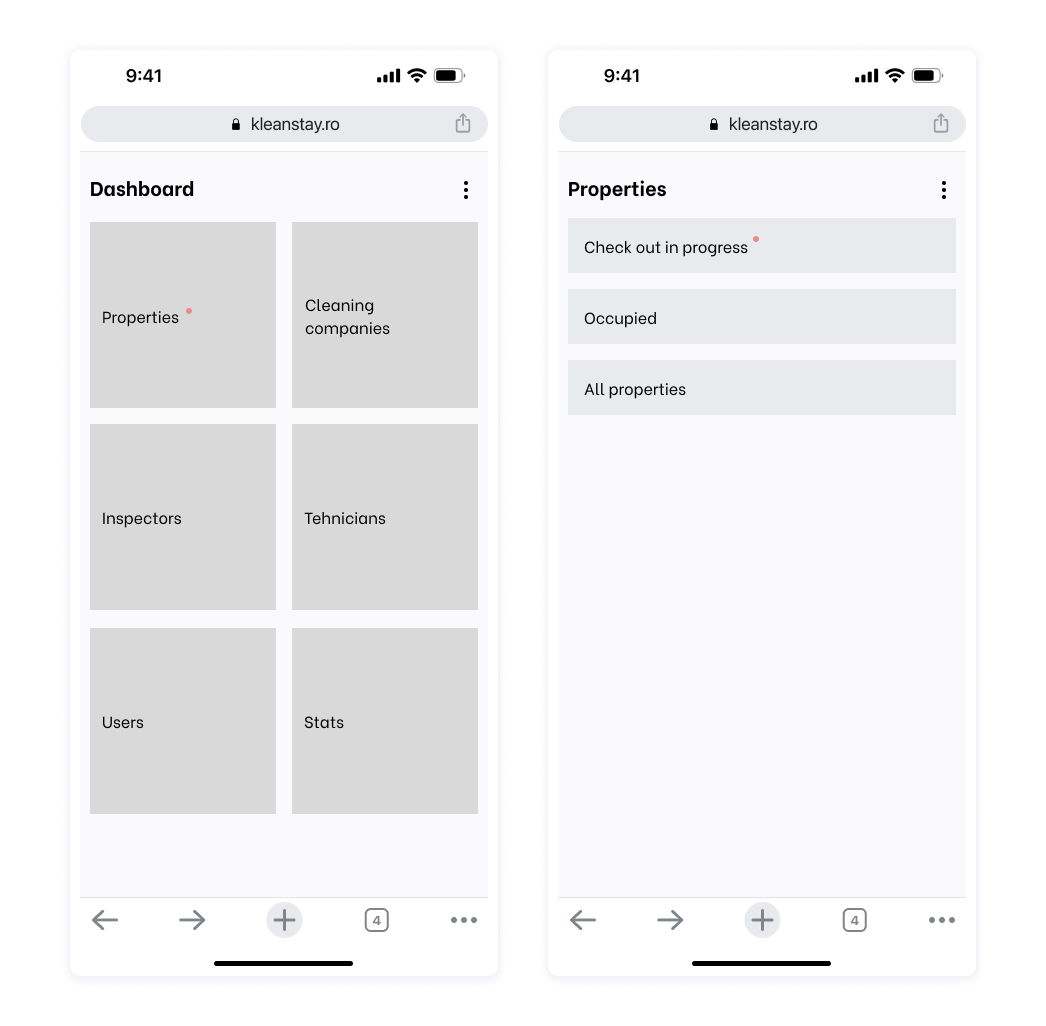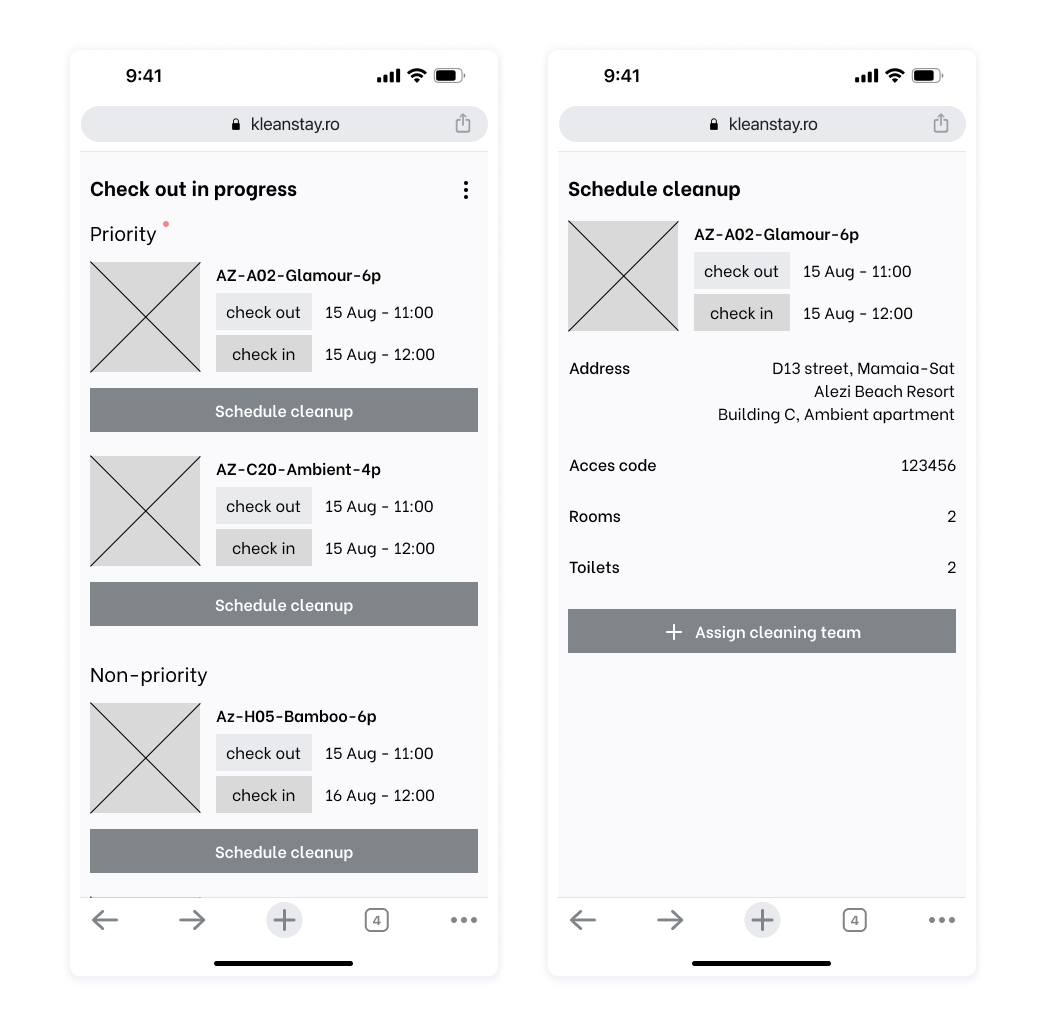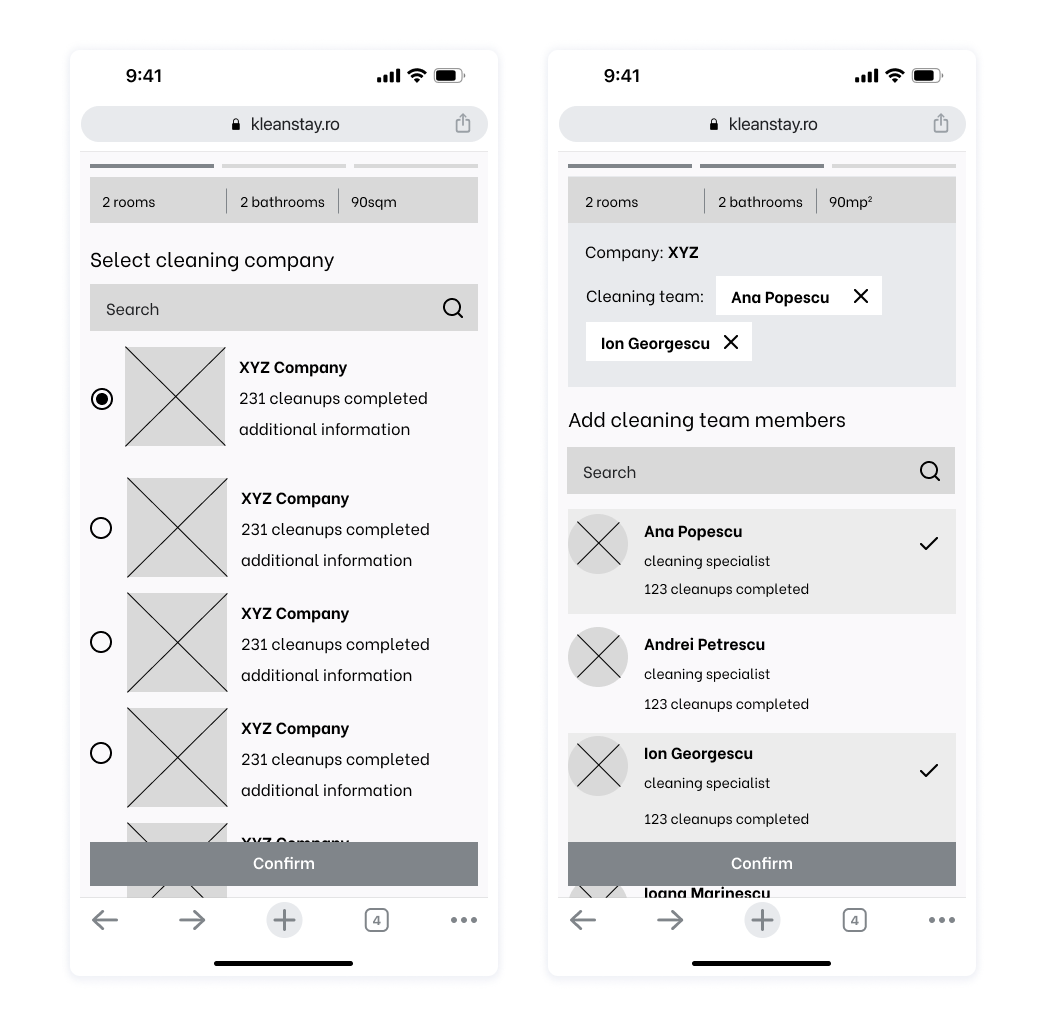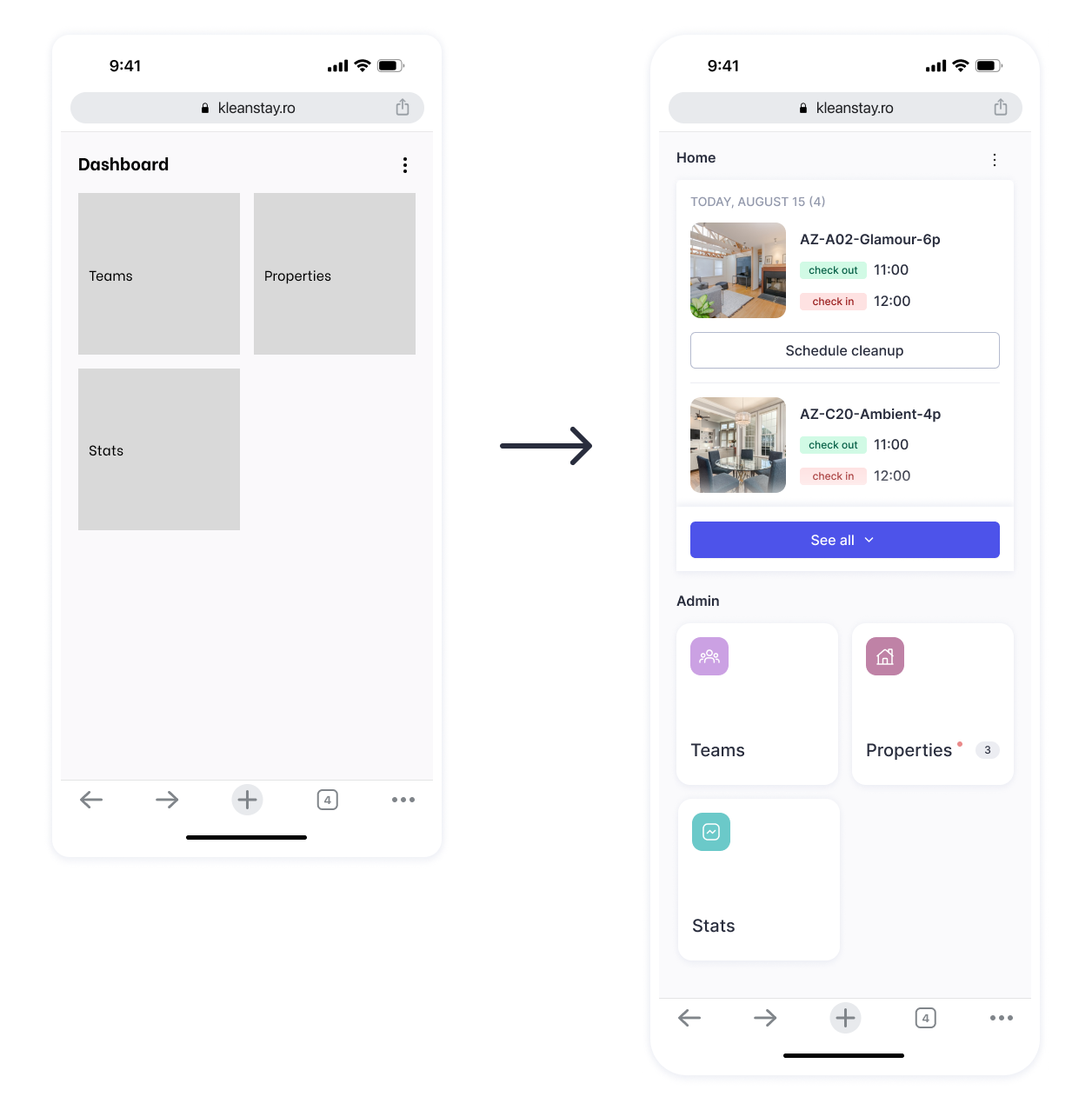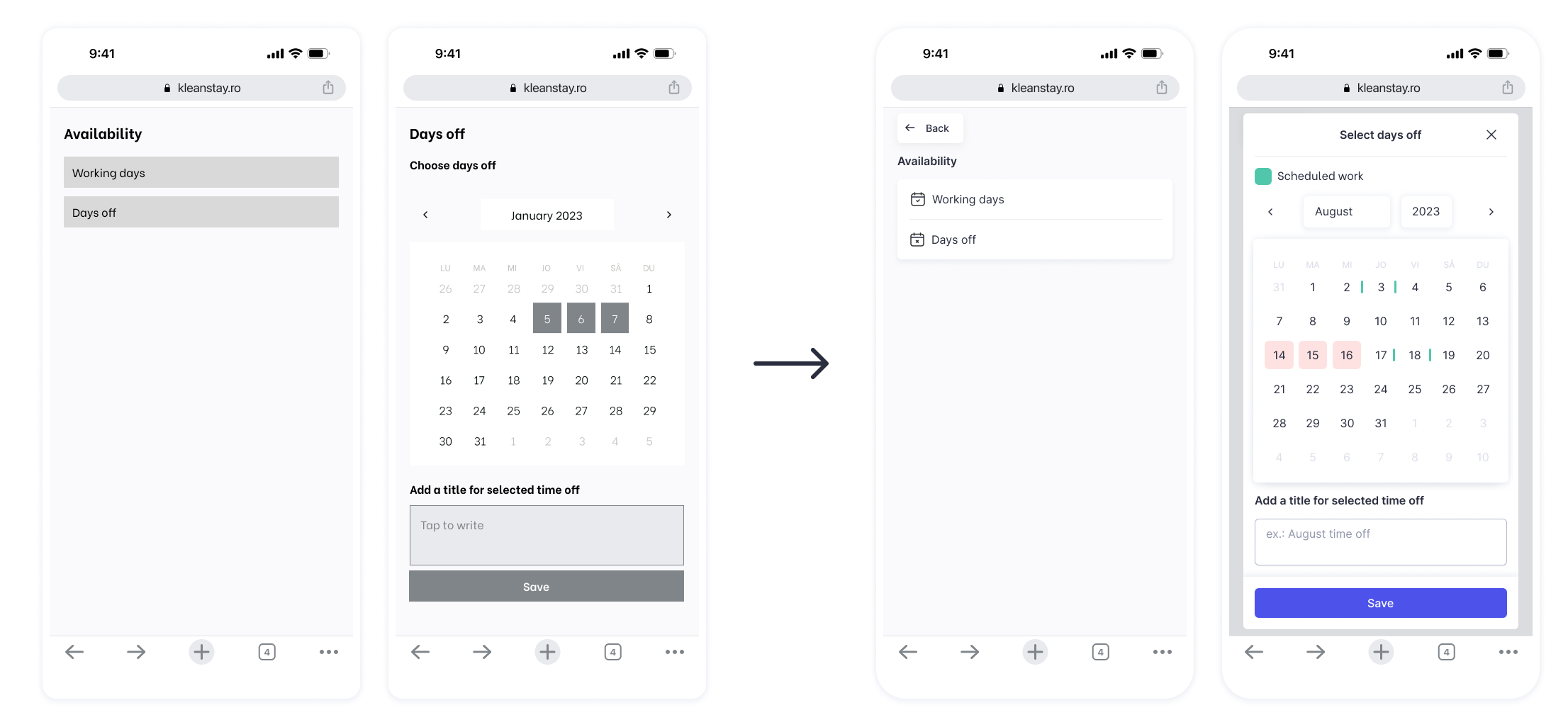Kleanstay
app • UI/UX case study • under development • 2023
overview
Kleanstay, a web-based mobile app, has been specifically designed to assist workers in the HoReCa industry with various tasks related to cleaning and maintaining different types of accommodations. Kleanstay is part of a trio alongside turo.ro, dedicated to private rental management, and KeyStay Guest App, a 24/7 virtual reception desk.
the challenge
Before the beginning of this project, the client relied on WhatsApp group chats for syncing their cleaning and maintenance staff - a tedious process that took up too much time. The client tried finding a tool to help automate these processes, but their research revealed that currently the market is lacking automated tools for facilitating the cleaning and maintenance procedures in vacation rental flats in the manner that they require.
my role
I was the project's sole UX designer, and I was in charge of overseeing the entire design process from beginning to finalization.
the goal
Kleanstay's goal is to provide an automated and customizable experience that assists HoReCa professionals in the cleaning and maintenance of all types of accommodations, as well as to streamline interactions between cleaning workers, cleaning company managers, technicians or room attendants, and housekeeping inspectors.
project constraints
The client requested a quick delivery of an alpha version of Kleanstay within a two-month timeframe, as the upcoming summer season was rapidly approaching. A cross-functional team consisting of a project manager, developers, and myself as the sole UX designer was established to facilitate the execution of the project. The primary objective of the alpha version of the application was to evaluate Kleanstay’s functionality and overall efficiency. We chose to use an existing UI kit due to timing restrictions.
where we started
We started off with a detailed project plan that described the business’ needs, the project scope, and functionality while also providing the research data acquired by the client's team. This plan served as the fundamental basis for the development of the app, as the information architecture relied heavily on the user flows described in the plan.
design process
Ideating
Wireframing
Hi-fi designs
Usability testing
ideation phase
The primary directions specified in the project plan guided the ideation phase. Here are some examples:
Core functionality: The app will provide real-time updates and notifications to cleaning companies, allowing them to select apartments to clean on a first-come, first-served basis. The app will also help monitor and track the cleaning process in order to ensure that apartments are ready for check-in in a timely manner.
Behind the scenes: The app will gather information on apartments with scheduled check-outs and check-ins on a daily basis and will prioritize flats with scheduled check-ins for the current day.
Dashboards: Kleanstay will feature 5 types of dashboards on 3 levels of access:
admin dashboard (access level 1): designed to monitor and enable the management of all aspects of the app. The dashboard will provide an overview of the entire system, allowing the administrator to view and manage all properties, cleaning companies, user accounts, and data associated with the app. The dashboard will provide the administrator with a complete picture of the app's performance and enable quick and effective decision-making to improve the app's performance and usability
cleaning company manager dashboard (access level 2): a central hub for all cleaning company managers to manage their teams and cleaning jobs, providing an overview of the company's performance, access to user (granted access level 3) and team management, as well as admin-assigned property management
cleaning company employee dashboard (access level 3): a screen designed for viewing assigned tasks and reporting issues
technician dashboard (access level 3): a section designed for previewing work orders, reporting issues, and managing work schedule
inspector dashboard (access level 3): a place that brings together the assigned tasks and an issue reporting functionality
Based on the directions provided by the project manager, I started exploring and experimenting with the information architecture of the app. The final structure of the information architecture is available here.
wireframing
During the wireframing stage, we focused on Kleastay’s functionality. Low-fidelity screens were used to allow the developers to start coding the backend of the product.
The low-fi wireframes were originally designed in Romanian (as KleanStay is currently aimed at a Romanian-speaking market) but have been translated for your convenience.
Admin flow: assigning cleaning companies to properties, choosing cleaning team members and sending out the request to the cleaning specialists
hi-fi designs
The refined designs include several adjustments to the original lo-fi flows. The changes are aimed at improving navigation and allowing for more customization, as well as providing more status feedback.
Cleaning company manager dashboard: lo-fi mockup vs hi-fi mockup
Cleaning company manager assigning properties to existing cleaning teams: lo-fi mockup vs. hi-fi mockup
Technician dashboard: lo-fi mockup vs hi-fi mockup
Technician adding time off to their schedule
usability testing
KleanStay's usability testing has been ongoing since its closed-circuit alpha release, which means the app is only available to a small number of people who are constantly providing feedback while using the product in real-life scenarios. Some of the feedback the product has received includes the following:
functionality bugs
a need for improving the property cleaning prioritization system (e.g.: stacking leftover cleanups from the previous day on top of the cleanups needed for the current day)
a need for a more customizable property cleaning prioritization system (e.g.: prioritization based on property amenities like bed linen)
a glimpse into the future
Kleanstay is currently in the user acceptance stage and is being tested with selected personnel from the client's staff team, therefore, it is not publicly accessible just yet. The app’s roadmap involves a full visual revamp, continued product development, and once it achieves the desired level of efficiency, the product will undergo a transformation into a Software-as-a-Service (SaaS) model (estimated time of delivery: early 2024), targeting the HoReCa industry for marketing and distribution purposes.
takeaways
During the course of this project, I had the opportunity to observe the impact of prioritizing functionality and addressing customer’s pain points, as opposed to adopting a more holistic approach to product development. Here is what we achieved:
Fast project delivery: my team and I were able to efficiently address client’s pain points in the limited time frame
Customer satisfaction: the client was happy with the overall result and expressed that the product significantly increased their efficiency on a day-to-day basis
Addressing bugs and functionality issues became less complicated than usual
The implementation of this strategy may have had several consequences of concern:
Missing improvement or innovation opportunities
Not encouraging or fostering discussions about late-occurring client pain points
Not fully considering the feedback of end users other than our own client
Difficulty integrating functionalities that were not taken into consideration during the early stages of development
However, I wholeheartedly believe in our team’s capacity to address complex issues, and we’re eager to embrace whatever comes up next.
